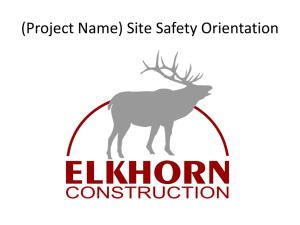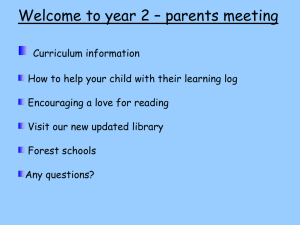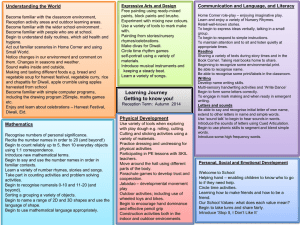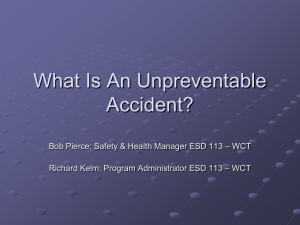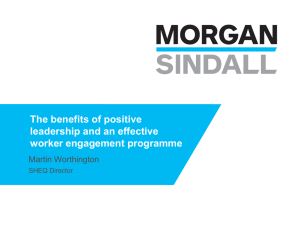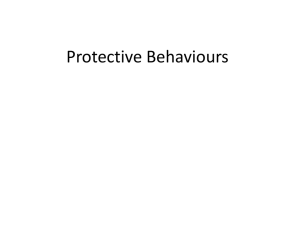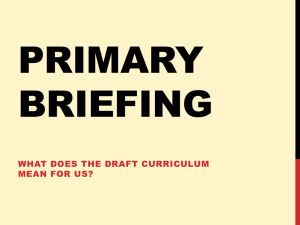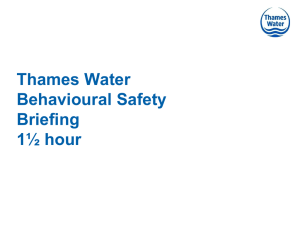Unit 4 – How to recognise potential risks in the care setting
advertisement
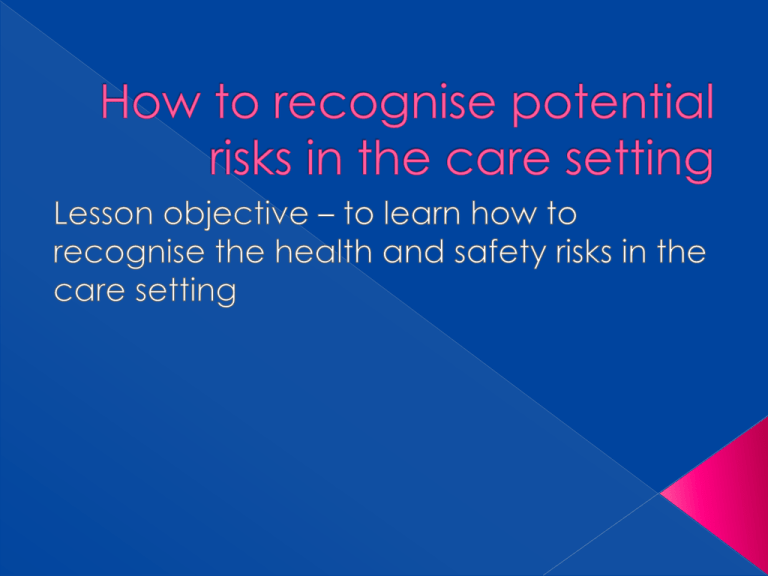
Working in groups list as many hazards that need to be considered in the care setting • Lesson objective – to learn how risk assessment is carried out and why in the care setting Fire Electricity Unsafe equipment Unsafe electrical fittings and fixtures Flood Gas leaks Unsafe furnishings and fittings Unsafe storage of hazardous chemicals Lesson objective – to learn how to recognise the health • and safety risks in the care setting Community lounge rooms Kitchen Play areas Bedrooms Community areas – such as hallways, entrances and stairs bathrooms • Lesson objective – to learn how to recognise the health and safety risks in the care setting Air-condition in the care setting is said to be 33% more likely to cause infection spread • Lesson objective – to learn how to recognise the health and safety risks in the care setting • Lesson objective – to learn how to recognise the health and safety risks in the care setting • Lesson objective – to learn how to recognise the health and safety risks in the care setting Looking • at the document and the image – write up six risk assessment areas that are vital to endure children are safe in the Lesson objective – to learn how to recognise the child care facility health and safety risks in the care setting Fire – smoke alarms, fire exists, fire fighting equipment – fire extinguishers and blankets Electricity – poor lighting or overloading sockets, and protection over sockets where children are playing Unsafe equipment – large equipment that could be dangerous should have guards on. Unsafe electrical fittings and fixtures- frayed wires should be taped up, sockets and plugs repaired Flood – could be caused by burst pipes, over flowing baths, water storage tanks, washing machines, dishwashers all need regular maintenance Gas leaks – boilers that are not regularly checked and gas ovens and hobs need maintenance checks by corgi registered plumbers. Unsafe furnishings and fittings – unsafe chairs should be removed, furniture that are unbalanced should be fixed. Unsafe storage of hazardous chemical – these should be kept in locked cupboards at all times Lesson objective – to learn how to recognise the health and safety risks in the care setting Risk assessments are carried out at regular intervals, fire prevention, food and hygiene as well as gas certificates are available for inspection. Surveillance cameras are installed in all main playrooms and entrances. We have an intercom at the entrance so that visitors are let in and aren't able to just walk-in. All parents need to sign their children in and out. Should someone different be collecting your child, Please inform your child's keyworker and provide some form of identification. 1. 2. 3. 4. 5. 6. 7. 8. 9. 10. 11. 12. Learn CPR Although most people will never need to perform it, CPR is always valuable to know when working as a babysitter. There are different techniques for performing CPR on adults, children and babies, so make sure you are up to date and able to perform CPR if necessary. Enroll in a class at a local community college, Red Cross or YMCA. Choking Hazards Do not bring toys that are potential choking hazards, such as toys with small, detachable objects. Keep any home decorations that are a potential choking hazard out of reach to any wandering and curious little hands. Make sure children stay away from blind cords as well, as children can wrap the cords around their necks. Lock Away Household Cleaners Children are curious by nature, which sometimes leads them to do things that may potentially harm them. While most parents will have toxic household cleaners out of the reach of their children, ask to make sure. If the child is being taken care of at your house, make sure to lock the cabinets that contain these items with a child-proof lock, or move them to a room that is off-limits or a shelf that is too high for the child to reach. Phone Numbers In addition to 911, it is important to have other phone numbers for non-life threatening emergencies (such as a broken arm) or to be able to contact the parent in case of an emergency. Have the cell phone number of the parent or parent(s) and the phone number of the place they are visiting (in case they turn their cell phones off). In addition, it is good to know what hospitals to take the children to in an emergency and have the numbers of the children's dentist and pediatrician on hand. Its also a good idea to have the phone number of at least one neighbor in case there is an emergency and the parents cannot be reached. Allergies Learn about the children's allergies before you begin babysitting. This is important if you are serving them food or are in a situation where they might need to be administered emergency care. Have the parents provide a list of allergies and ask them to show you where to locate treatment options, like an Epipen if the child is extremely allergic to certain foods, animals or insect bites. Watch the Children Always watch the children. This may seem like common sense, but some babysitters use babysitting as a time to call their friends or slack off. Turning your back for a moment can result in a catastrophe. This is of utmost importance when you are out in public with the children, as they can run away or be seriously injured in the blink of an eye. Transporting When transporting the children you are caring for, make sure your car is fitted for their car seat. Have the parents show you how to put it in and make sure it is secure. If you are walking with the children, make sure they stop at any and all street corners. It is preferable that you hold their hands or hold onto their backpacks so that you don't lose them when crossing the street. • Lesson objective – to learn how to recognise the health and safety risks in the care setting 13. 14. Look at the image and highlight all the areas that are safe from dangerous and how they have been remedied 1. 2. 3. 4. 5. 6. 7. Fire and smoke detectors, carbon monoxide detectors Water Standard dry powder Multi-purpose dry powder AFF (Aqueous film-forming foam) this is used to put out fires that are a solid object, it should never be used on a chip pan Carbon dioxide – it may be used on fires such as grease, fats, oil, paint, petrol, and so on. Smoking is a major cause of fires, some are started deliberately this is known as arson • Lesson objective – to learn how to recognise the health and safety risks in the care setting Class A Class A: SOLIDS such as paper, wood, plastic etc Class B: FLAMMABLE LIQUIDS such as paraffin, petrol, oil etc Class C: FLAMMABLE GASES such as propane, butane, methane etc Class D: METALS such as aluminium, magnesium, titanium etc Class E: Fires involving ELECTRICAL APPARATUS Class F: Cooking OIL & FAT etc Class B Class C Class D Class E Class F 1. 2. 3. 4. 5. 6. Working in groups record an emergency procedure for a fire in a care home setting Key words Break point glass Ring 999 – ensure someone has Doors and windows If small two people could fight the fire with fire extinguisher Everyone evacuated Never return to building until all clear has been given Doors Signs Safety feature Fire exit Smoke alarm Fire alarm purpose How it would reduce the risk The specific objectives of such training are to ensure that all employees: Are familiar with the procedure to follow if they discover a fire. Understand the fire alarm signals in the building in which they work, and know what to do if the fire alarm sounds. Know all the escape routes in the building in which they work, and assembly points. Are able to operate the fire alarm system. Know where fire extinguishers are located and how to use them. Understand the fire precautions in the building in which they work, so that they do not negate these precautions. Understand the serious threat that a fire in a building may present to life, property and the continuity of work Electronic pads on doors Window guards Safe-Condition Signs Prohibition Signs Mandatory Signs Warning Signs
